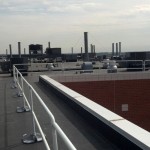Fall Protection On New Construction: Our Wish List For Architects
Pre-Plan Fall Protection On New Construction During The Design Phase
 For new construction projects, we are often asked to bid on procurement and installation of fall protection equipment. All too often, we find that it is treated as an afterthought, rather than an integral component of a well-designed building. We are alarmed whenever a contractor who has asked us to bid a project says, “They will add that later”, when we point out that the plans and specifications either say nothing about fall protection, or mention it without providing any scope, location or other layout information.
For new construction projects, we are often asked to bid on procurement and installation of fall protection equipment. All too often, we find that it is treated as an afterthought, rather than an integral component of a well-designed building. We are alarmed whenever a contractor who has asked us to bid a project says, “They will add that later”, when we point out that the plans and specifications either say nothing about fall protection, or mention it without providing any scope, location or other layout information.
Because anchor points are generally attached to structural members of the building, adding them in after construction is substantially completed can lead to cost overruns, penetration of a brand new roof (with the resulting warranty issues), inadequate structural strength where an anchor is needed and similar problems. FallProof offers both consulting and design and engineering services to architects and contractors during the planning phase of new construction.
Follow European Standards: Eliminate Fall Hazards and Reduce Risks During The Design Phase
Unlike in the U.S., in Europe, there is an explicit duty on architects to eliminate fall hazards and reduce risks during the design phase to the extent it is reasonably practical. We believe that U.S. design firms should act as if this standard also applied here, until such time as OSHA incorporates similar regulations. By doing this, they will best serve their owner clients, who will end up with a safer workplace for their tenants, maintenance teams and employees. It also will prepare forward-thinking firms for the inevitable when similar regulations become standard in the U.S.
For Rooftop Fall Protection, Consider That Parapet Walls and Guardrails Require No Training
 Where appropriate, the preferred form of rooftop fall protection is either guardrail systems or parapet walls because they require no worker training or special equipment. Either of these systems can be designed in, however, once construction has started, it is difficult or impossible to modify the plans to include a parapet wall.
Where appropriate, the preferred form of rooftop fall protection is either guardrail systems or parapet walls because they require no worker training or special equipment. Either of these systems can be designed in, however, once construction has started, it is difficult or impossible to modify the plans to include a parapet wall.
In one recent situation, a new building was designed and built with a parapet wall approximately 30” high in a location frequented by maintenance workers. Because it was less than 42” high, the parapet provided no protection without modification. Once built, the easiest solution would have been to add railing at least 12” high to the top of the existing wall; however, that alternative was rejected by the architect because it interfered with the aesthetic design of the building.
The remaining alternative was to install a horizontal lifeline along the inside of the parapet. On closer analysis, however, our structural engineer determined that the parapet wall did not have the strength needed to withstand the force (plus the margin of safety) that could be generated by a falling worker attached to the lifeline. The ultimate (costly) solution involved penetrating the brand new roof to install structural supports to which the lifeline could be attached. This entire situation could have been avoided with proper considerations during the design phase, when the parapet wall could have either been made 42” high, or constructed with the strength needed to support a horizontal lifeline.
For Green Roofs, Resolve Issues At The Outset
 Green roofs have many advantages and useful features, but they also have special issues from a fall protection standpoint that should be considered during the design phase. Chief among them is the fact that they require more workers on the rooftop due to the need to maintain the “live” roof.
Green roofs have many advantages and useful features, but they also have special issues from a fall protection standpoint that should be considered during the design phase. Chief among them is the fact that they require more workers on the rooftop due to the need to maintain the “live” roof.
Where a parapet wall or other type of perimeter system is used, care must be taken to ensure that the barrier will be at least 42” from the walking surface, and not as measured before the addition of dirt, grass and other plants. When anchor points or horizontal lifelines are used instead of an edge barrier, the number of workers that need to use the system at one time, as well as the nature of the work they are doing, must be considered. As an example, if someone will be moving near unprotected edges while watering with a hose, horizontal lifelines would be more appropriate than fixed anchor points.
For Cameras, Lighting, Flags and Signage, Be Aware of Unsuspecting Danger
We often see cameras, lighting, flags, and signage mounted to the side of a building just below the roof. Access for maintenance then involves either the use of a lift from the ground or, depending on the height of the building, leaning over the edge. In the case of lighting and security cameras, we recommend that the entire system be suspended from a davit arm so it can be “pulled in” for maintenance, which then eliminates the fall hazard.
To Eliminate Fall Hazards, Allow Our Experts To Guide You During Design Phase
 We invite design firms to call us with any questions about how workplace safety can be implemented during the planning and design phase (click on the blue button below to initiate a call, or complete our online contact form wherein you can submit drawings and other materials for our review). Alternatively, you can take our competent person training course or invite one of our experts to attend one of your in-house training sessions.
We invite design firms to call us with any questions about how workplace safety can be implemented during the planning and design phase (click on the blue button below to initiate a call, or complete our online contact form wherein you can submit drawings and other materials for our review). Alternatively, you can take our competent person training course or invite one of our experts to attend one of your in-house training sessions.

